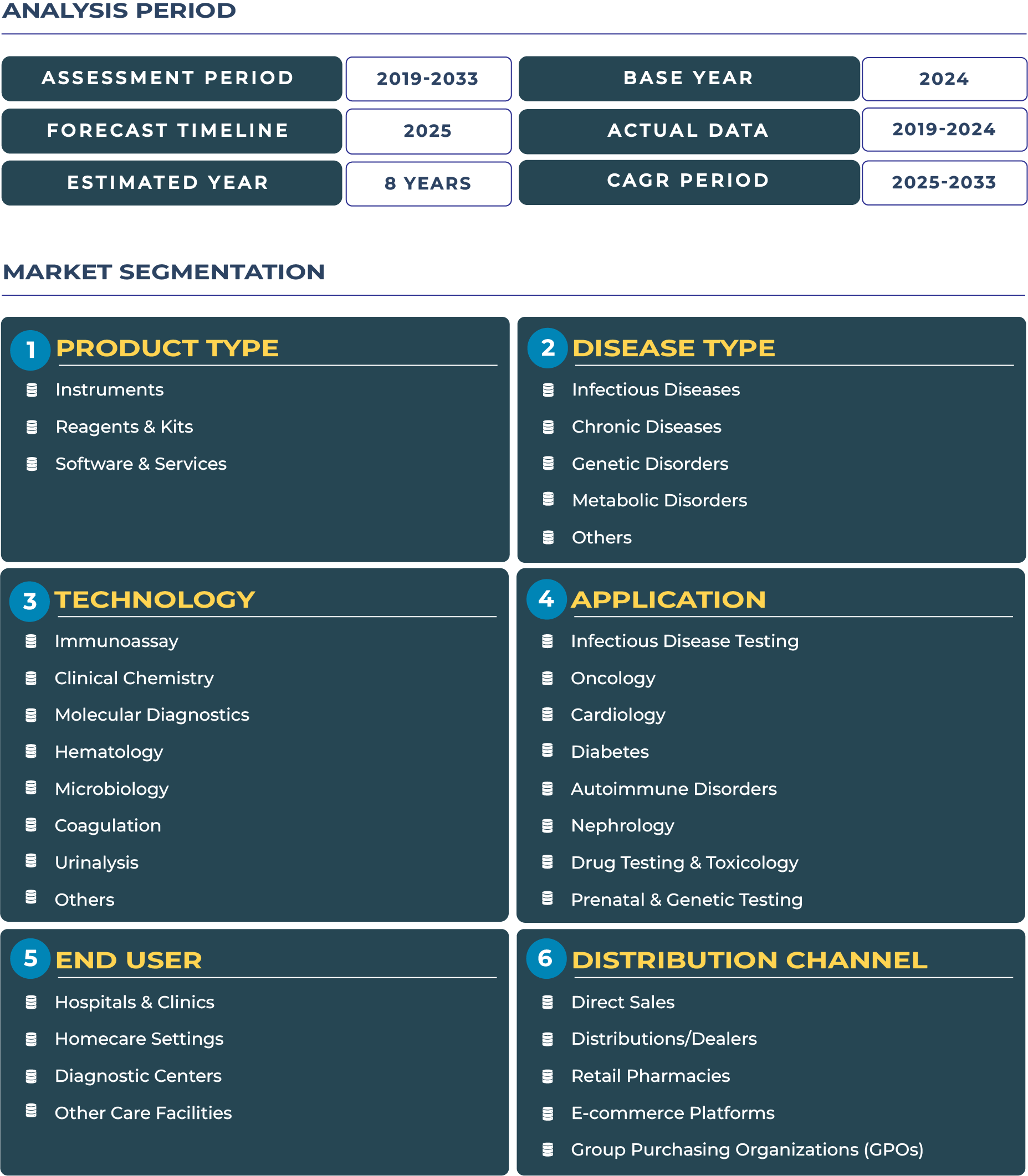Peru’s Healthcare Modernization Fueling Diagnostic Growth: An Era of Emerging IVD Demand
Peru’s healthcare modernization efforts are setting the foundation for a new era of diagnostic expansion, particularly within the in-vitro diagnostic (IVD) market. Over the past few years, Peru has invested heavily in improving access to medical technologies and strengthening hospital networks, especially across Lima and key provincial cities. These initiatives are aligned with broader national healthcare goals set by the Ministry of Health of Peru (MINSA) to improve early disease detection and laboratory automation. The modernization drive has opened pathways for private investments, improving clinical capabilities and laboratory efficiency across public and private sectors alike.
The Peru In-vitro Diagnostic Market is projected to grow from USD 360.4 million in 2025 to USD 598.3 million by 2033, expanding at a steady CAGR of 6.5% during 2025, 2033. This growth is attributed to rising investments in hospital infrastructure, growing adoption of point-of-care diagnostics, and digitization of pathology networks. Urban centers such as Lima, Arequipa, and Trujillo are driving this transition through increased private laboratory chains, integration of diagnostic software platforms, and expansion of reagent-based testing facilities. The country’s improving economic stability, supported by ongoing policy reforms, has strengthened the base for consistent IVD market expansion, even amid global economic fluctuations.
Private Hospital Chains and Medical Tourism Driving Peru’s Diagnostic Market
Peru’s healthcare transformation is being accelerated by the rise of private hospital chains that offer state-of-the-art diagnostic services. Prominent healthcare groups such as Clínica San Juan Bautista and Clínica Ricardo Palma are expanding diagnostic capabilities through partnerships with global diagnostic firms. These institutions are adopting high-efficiency analyzers, reagent automation systems, and integrated software solutions that enhance workflow accuracy and turnaround time. The expansion of private diagnostics also supports medical tourism, as Lima continues to position itself as a competitive hub for regional healthcare services.
Public hospital upgrades under government programs, such as the national “Hospitales Bicentenario” initiative, further complement this trend by expanding testing capabilities in regional hospitals. Combined with rising awareness of preventive health, these developments are fostering demand for advanced immunoassay systems, hematology analyzers, and molecular testing kits. The synergy between public policy, clinical expertise, and private investment has created a robust framework for IVD sector expansion.
Challenging Terrain and Supply Chain Delays Restricting Broader IVD Adoption
Despite notable advancements, several barriers persist that constrain the full potential of the Peru In-vitro Diagnostic industry. The country’s geographic diversity, particularly across the Andes and Amazon regions, creates logistical and cost challenges in reaching rural healthcare facilities. Transporting diagnostic reagents and maintaining temperature-sensitive materials in remote areas remains a major operational bottleneck. This challenge limits consistent test availability outside urban centers and contributes to uneven healthcare access.
Procurement delays in public sector institutions also affect the timely delivery of instruments and reagents. These delays, combined with low IVD penetration outside Lima, hinder uniform adoption of diagnostic technologies. Moreover, the absence of structured distributor networks in certain provinces complicates the supply chain ecosystem. To address these issues, there is a growing emphasis on creating decentralized diagnostic models supported by mobile and point-of-care solutions that can bridge rural diagnostic gaps.
Private Chain Expansion and Donor-funded Projects Reshaping Regional Diagnostic Infrastructure
In Lima, private diagnostic chains continue to expand aggressively, introducing automation and digital integration across their service lines. This shift is accompanied by donor-funded healthcare programs aimed at strengthening diagnostic services in underserved regions. International collaborations between Peru and global organizations have led to the deployment of essential testing technologies for infectious and chronic diseases in community hospitals. These efforts, often backed by institutions like PAHO Peru, contribute to improved screening accuracy and data-driven health interventions.
Additionally, inbound medical tourism, particularly for affordable diagnostic procedures, is gaining traction. The convergence of quality, cost competitiveness, and digital innovation is positioning Peru as a regional diagnostic hub. As more diagnostic facilities integrate laboratory information systems (LIS) and adopt reagent automation, operational efficiency and data integrity continue to improve. These trends collectively enhance patient experience and strengthen Peru’s diagnostic care delivery model.
City-Center Hubs and Local Distributor Training Unlocking New Growth Opportunities
A significant opportunity for stakeholders in the Peru In-vitro Diagnostic ecosystem lies in the creation of city-center diagnostic hubs and the development of skilled local distributors. Concentrating testing hubs in major cities like Lima, Cusco, and Arequipa allows for scalable operations while ensuring rapid test delivery to satellite laboratories. Simultaneously, the training of local distributors in handling reagents, instruments, and calibration protocols is improving diagnostic reliability.
Affordable diagnostic lines are also gaining relevance as manufacturers adapt product offerings to the local market. For instance, compact analyzers and software-integrated testing platforms are being customized for mid-sized hospitals and private clinics. Government incentives encouraging local assembly and production of IVD kits further expand market potential. The alignment of these strategies with public health objectives ensures that Peru IVD industry maintains a growth trajectory that is both inclusive and sustainable.
Strategic Localization and Partnership Models Defining Competitive Landscape
The Peru in-vitro diagnostic landscape is characterized by a mix of international and local players investing in sustainable growth strategies. Global companies such as Roche, Abbott, and Siemens Healthineers continue to dominate through partnerships with Peruvian distributors to expand molecular testing and immunoassay platforms. These firms focus on training key opinion leaders (KOLs) in Lima and other high-potential cities to strengthen clinical knowledge and product adoption.
Localization strategies are proving essential, as global suppliers offer affordable reagent bundles and flexible service contracts to sustain operations amid economic uncertainties. Local firms are also entering collaborative ventures to develop low-cost kits and software tools tailored for domestic laboratories. Concentrating operations in Lima allows quicker scalability and visibility, while regional expansion efforts continue through technology-sharing agreements. Together, these strategic moves ensure that the IVD sector remains dynamic, resilient, and competitive across Peru’s evolving healthcare environment.







